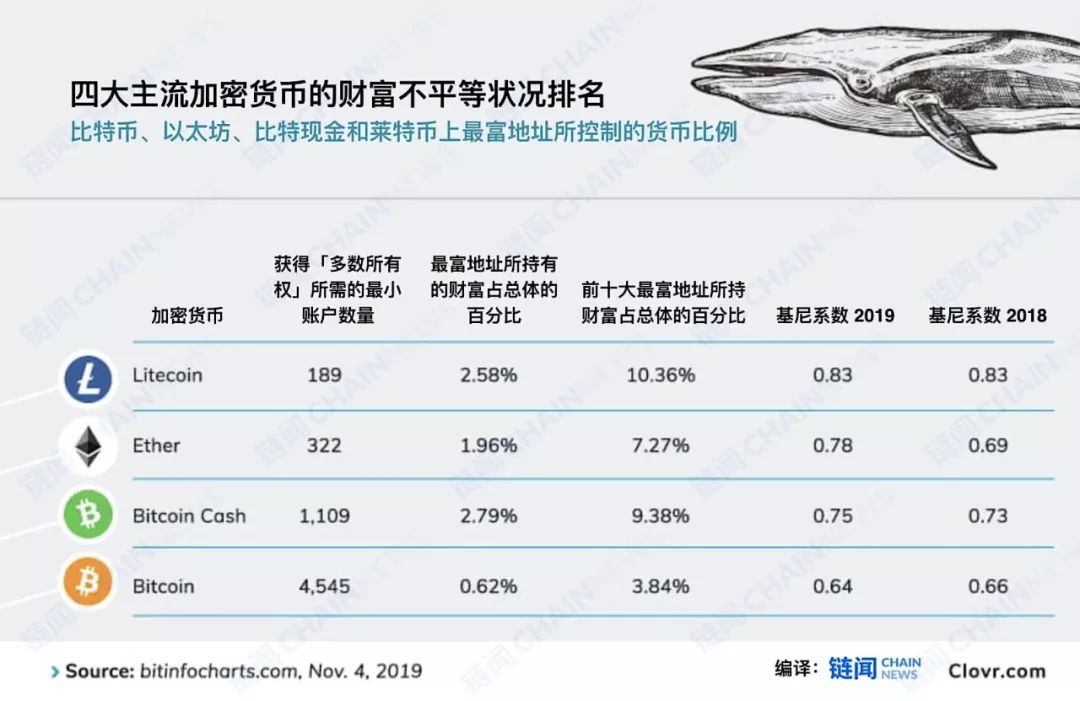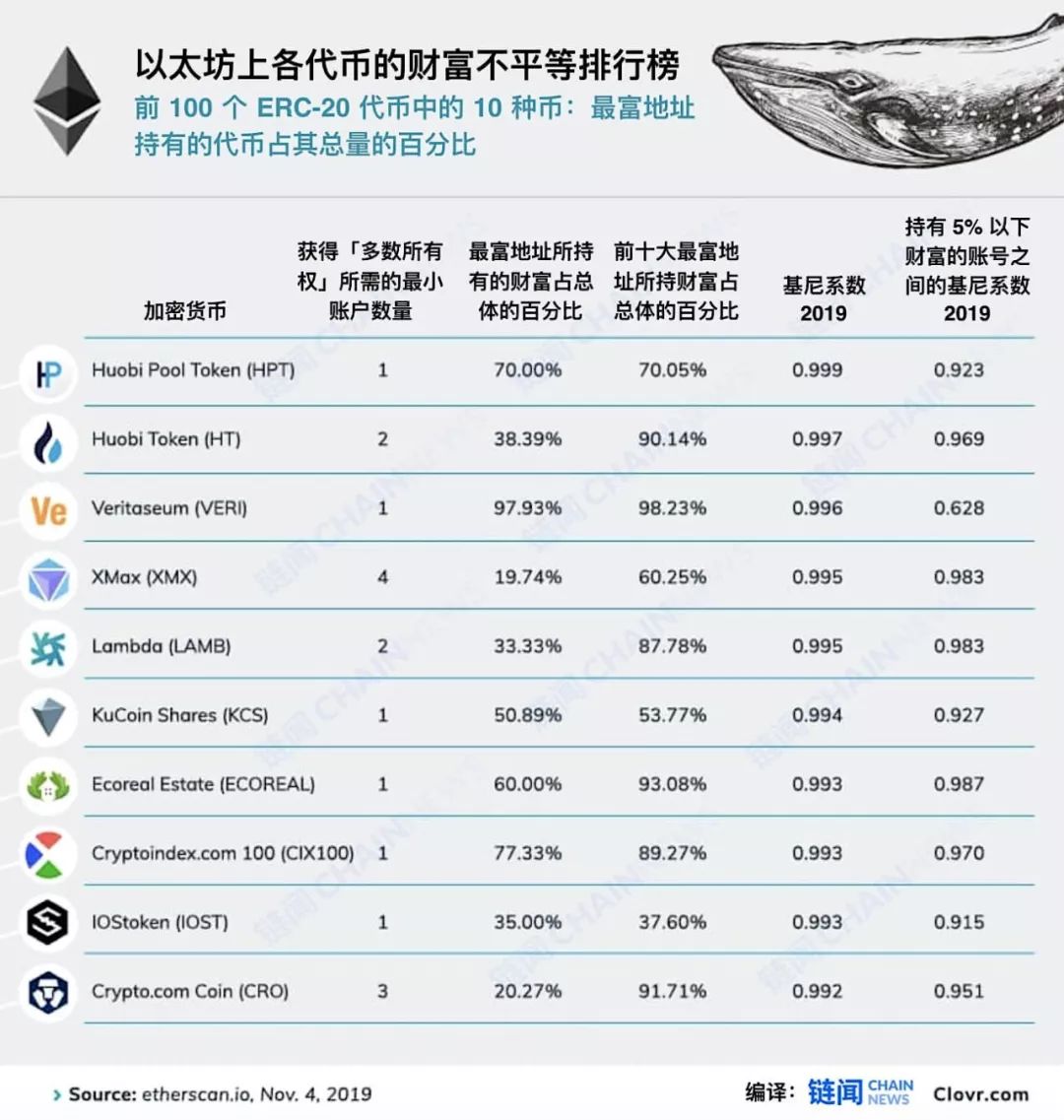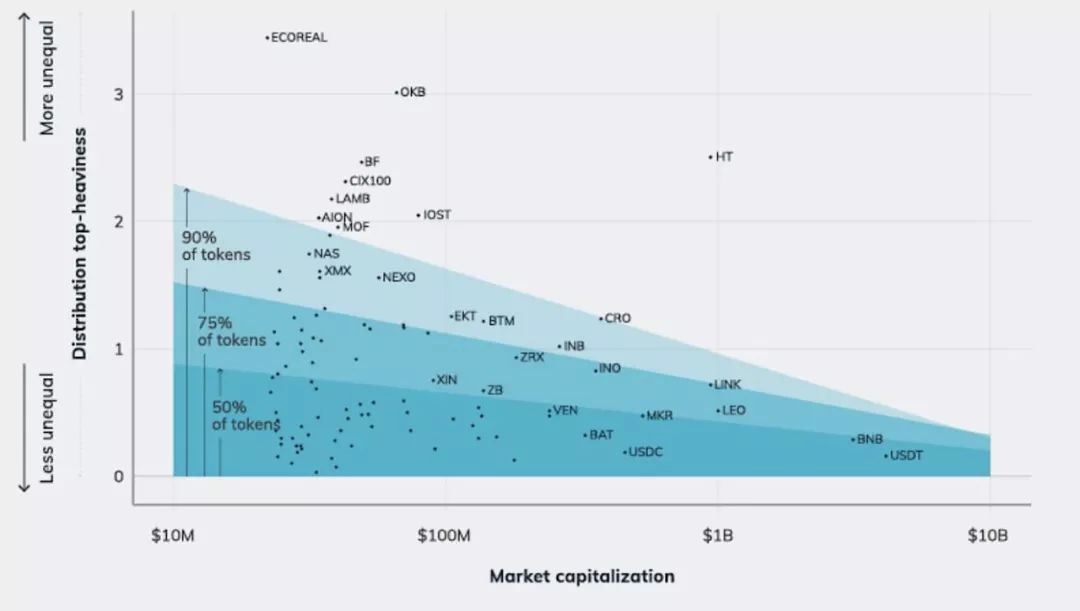Analysis | Which blockchain projects have the largest number of giant whales in the "ocean"?
Source: Chain News, the original title "Which Blockchain Projects Can Giant Whale Set Off? 》
Written by: Clovr Research Team
Translation: Lu Jiangfei
Let's start with a mid-2018 story. On July 31, 2018 , a Bitcoin investor logged into a cryptocurrency exchange and bet on Bitcoin worth 416 million USD. He bet that the price of Bitcoin will rise. But the market did not perform as he wished, and the price of Bitcoin fell by 5%. The investor's stake cannot cover the losses, and the exchange can only use the profits of other investors to "fill the pit."
- How will the US election affect crypto legislation?
- Zhu Jiaming's speech at the United Nations Blockchain Forum: Actively Facing the Challenges of the Global Trust Crisis and Trust Deficit
- Popular Science | DeFi Beginner's Guide
Translation note: According to the exchange's risk control management mechanism, when purchasing bitcoin contract products, when the margin insurance cannot cover all the losses of the total margin recovery, full account allocation is required.
The actions of an investor can have a wide range of consequences. This story shows that in the turbulent cryptocurrency market, those rich people, such as giant whales, can set off rough seas. Like the giant whale in the sea, as long as the transaction volume of some cryptocurrency investors is large enough, it can affect the value of the cryptocurrency itself, and may also destroy the decentralization principle based on the blockchain and cryptocurrency industry.

In this article, we obtain data from four mainstream cryptocurrencies and the 100 most valuable token projects on Ethereum, and study the distribution of cryptocurrency wealth by comparing the situation of 140,000 non-exchange addresses. Through these studies, some of our findings are startling:
- There are multiple cryptocurrency projects that require only a few accounts to control their "majority ownership";
- Compared to 2018, the distribution of wealth in some cryptocurrencies has now become more unequal.
The situation of the giant whale of the four major coins
Some giant whales are so rich that they only need a small group to “hold a group” to control the majority share of a cryptocurrency. If this cooperation is malicious, it is a bit like a “51% attack”.
In theory, cryptocurrencies with a smaller market value are more vulnerable to attacks by the giant whales that control the chain.For example, Bitcoin Gold was robbed in 2018. (Annotation: It was attacked by a malicious miner who successfully implemented a double spend and stole more than 388,200 bitcoin gold tokens from the exchange, which was worth up to $ 18.6 million at the time. )
How many addresses do the most mainstream cryptocurrencies need to control most of their wealth? Let's take a look at the following table:

Data source: bitinfocharts.com, November 4, 2019
Before entering the conclusion, we need to clarify that one address does not represent one person, because one person may hold multiple addresses, and some of the richest addresses are actually held by exchanges, and exchanges usually hold the wealth of many people . In order to make this analysis closer to the general situation of "individuals", we have eliminated known or inferred addresses owned by the exchange.
We studied the wealth distribution of four major cryptocurrencies , namely Bitcoin , Ethereum , Bitcoin Cash, and Litecoin ; we found:
- Litecoin's wealth is the most centralized. To obtain the "majority ownership" of Litecoin, you only need to own the first 189 addresses. The top ten most Litecoin addresses have a tenth of the total Litecoin wealth.
- Among the mainstream cryptocurrencies, Litecoin's wealth distribution is probably the most unequal, while the native currency of the Ethereum platform, ETH, is the only cryptocurrency that has experienced an increase in wealth inequality since 2018. We used the Gini coefficient as an indicator to analyze the overall wealth distribution of the top 10,000 richest addresses of each of the four mainstream cryptocurrencies. We found that the Gini coefficient of Ethereum, or the degree of wealth inequality, increased by 13 from 2018 to 2019 % (0.69 vs. 0.78) .
- Among the four major cryptocurrencies, Bitcoin has the lowest wealth inequality, with a Gini coefficient of 0.64 in 2019.
Annotation: Gini coefficient is an indicator of wealth distribution, first proposed by Italian statistics and sociologist Corrado Gini in 1912. The maximum Gini coefficient is "1" and the minimum is "0". The closer it is to 0, the more equal the income distribution is. International practice regards 0.2 as the absolute average income, 0.2-0.3 as the relatively average income, 0.3-0.4 as the relatively reasonable income, 0.4-0.5 as the income gap is large, when the Gini coefficient is above 0.5, it means that the income disparity .
In order to feel this number more intuitively, we can make a less precise comparison: the Gini coefficient of the United States' income in 2018 reached 0.49, a record high. This shows how serious the wealth inequality of cryptocurrencies is.
Big fish in small pond
The wealth distribution of Ethereum ERC-20 tokens ( currency based on the Ethereum platform) is not the same as the situation of the four major cryptocurrencies mentioned above. Of the top 100 Ethereum tokens with the highest market capitalization, the number of addresses required to obtain " majority ownership " is only 34 on average. However, the number of addresses required for each token to gain majority ownership varies widely. Of the top 100 Ethereum tokens with the highest market capitalization, 24 tokens need only one address to control "majority ownership", and this address is almost always owned by the creator of the token.

Wealth inequality ranking of various tokens on Ethereum
This situation occurs because the way these tokens are issued is usually controlled by their founders, but this centralized wealth control brings its own risks. Some projects funded by initial token financing are actually scams. They induce more funds to enter to raise the price of the token, just for the founder to cash out a large amount of tokens he holds. Even if it's not a scam, investors need to deal with an unpredictable and poorly regulated market.
Taking the Veritaseum token as an example, among the 100 tokens we analyzed, the wealth inequality of the token ranked third (the Gini coefficient was as high as 0.996) . Its founder, Reggie Middleton, was convicted of illegally profiting from the initial coin offering and ordered to return $ 8 million to investors in November 2019.
The wealth distribution of tokens or cryptocurrencies has different meanings depending on how the currency is generated. According to our analysis, of all the Ethereum tokens, the cryptocurrency exchange Huobi's tokens have the highest wealth inequality, but Huobi did not raise funds through the initial token issue, so the investment of HT token They do not take the same level of risk.
In short, the investment situation of each crypto token is really different.
Tokens with small market capitalization have the biggest difference in wealth inequality
The following figure shows the wealth distribution of ERC-20 tokens. Among the top 100 Ethereum ERC-20 tokens, the relationship between the market value of the tokens and the distribution of wealth.

In order to better understand which tokens are most likely to have a very unequal wealth distribution (that is, only a few people can dominate the market or be manipulated by its founders) , we focus the market value of each token and its wealth distribution head Top-heaviness . The so-called head-centralized wealth distribution refers to the large amount of wealth of a token held by a few addresses. The definition here is the logarithmic ratio of the average number of address wealth to the median address wealth.
The higher the market value of a token, the more likely its wealth distribution is more even (compared to other tokens) . In other words, a large number of tokens whose wealth is concentrated in a few addresses are all tokens with a relatively small market value. To be more specific, they are actually tokens with a market value equal to and lower than 100 million US dollars.
If you are a cryptocurrency investor worried that wealth centralization will bring risks, then one suggestion that may be useful is to try to avoid buying tokens with a market value of less than $ 100 million. Mature coins like Binance Coin and Tether may have a wealth distribution similar to mainstream currencies like Bitcoin. why? Maybe the more successful the token, the easier it will be to attract more investors, thus distributing wealth to more addresses. Tokens with smaller market capitalization may not be mature enough, and their distribution of wealth may gradually become even over time.
to sum up
The design goal of the encryption system is to achieve stable development through decentralization, and centralized wealth ownership will form a particularly vulnerable point of attack. This is especially true for centralized exchanges, as they are the sole custodians of many people's wealth. This vulnerability may and has been attacked. The bigger the whale, the bigger the target-hackers and fraudsters are already holding up large harpoons for hunting.
We found that Litecoin is more susceptible to the impact of the giant whale than Bitcoin, Ethereum or Bitcoin Cash, and Ethereum is the only platform among the four that will see increased wealth inequality among the richest addresses in 2019. When we examine the wealth distribution of ERC-20 tokens on Ethereum, we find that their concentration is more serious than the four largest cryptocurrencies. Of the tokens on Ethereum, the "majority ownership" of one of the four is controlled by the project founder. For some people, a token project with a small market value is a profitable investment because the returns can be high, but the potential risks are also quite high.
Before buying any cryptocurrency, investors need to do a thorough research and examine a number of factors. One of them is to understand how big the whale is in the "ocean" of the cryptocurrency you want to invest in. You can either swim in the rapids or be swept away by the stormy waves they set off.
Methodology and limitations
We collected the balance data of the richest 10,000 addresses in Bitcoin, Ethereum, Bitcoin Cash and Litecoin from bitinfocharts.com, and collected each of the top 100 Ethereum ERC-20 tokens by market capitalization from etherscan.io The top 1,000 addresses with the richest tokens. This analysis collected data on address balances on August 16, 2018 and November 4, 2019, and analyzed the annual change in wealth distribution between these addresses. Collecting data for these two dates is equivalent to giving a snapshot of market fluctuations, rather than some continuous trend.
Some research on cryptocurrency giant whales has long acknowledged that an address is not equal to an investor, but they have not solved the problem. One of the pillars of the cryptocurrency ecosystem is the anonymity of addresses, but anonymity has become an obstacle when studying the distribution of wealth. One of the most troublesome problems we encountered when studying the giant whale is that the exchange actually holds some of the richest addresses, which makes it easy for people to mistake many people's wealth as "one person" wealth. Although some people think that the data of the exchange should not be ignored (because most exchanges are also the custodian of the currency of their user accounts) , in order to make the results easier to analyze, we finally decided to remove the address of the exchange.
By analyzing the wallet nickname associated with each address, we identified the addresses belonging to 41 exchanges. Then cross-reference the address names of the exchanges on each chain to find out which anonymous addresses are also owned by the exchange. The addresses of two (or more) cryptocurrencies are assumed to be exchange addresses, and these addresses have been eliminated in this analysis. In our data set, only a little over 6% of addresses hold more than two cryptocurrencies. Addresses holding more than two currencies generally hold more than three times the currency (for two or less currencies, the average balance = 0.06% of the supply; for more than two currencies, the average balance = 0.28 of the supply %) .
We calculated the percentage of total coins owned by the richest addresses, and also calculated the number of addresses required for each cryptocurrency to have "majority ownership." After excluding exchange addresses, based on the rank of wealth distribution based on double logarithmic coordinates, we identified those addresses with abnormally large balances. In order to study the relationship between the market value of cryptocurrencies and the distribution of wealth, we estimated the quantiles of 50%, 75%, and 90%, and used quantile regression to make it a function of market value.
We will continue to update Blocking; if you have any questions or suggestions, please contact us!
Was this article helpful?
93 out of 132 found this helpful
Related articles
- Former CFTC chairman intends to promote "digital dollars" through non-profit foundations
- 2020 Winter Davos Forum Blockchain Preview: Digital Currency Becomes Core Issue but Has No Chinese Role
- The blockchain market raised 4.7 billion U.S. dollars a year, accounting for 40% of the total financing of 129 exchanges
- Bitcoin option fever skyrocketed, trading volume approaching historical highs or becoming price booster
- Behind 106 market cases, we discovered the impact of the BTC spot market structure on price discovery
- Crypto crime reports: billions of dollars of money laundered, more than half flow into exchanges
- Blockchain distributed storage: a new storage model for ecological big data






